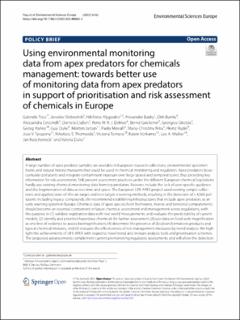| dc.contributor.author | Treu, Gabriele | |
| dc.contributor.author | Slobodnik, Jaroslav | |
| dc.contributor.author | Alygizakis, Nikiforos | |
| dc.contributor.author | Badry, Alexander | |
| dc.contributor.author | Bunke, Dirk | |
| dc.contributor.author | Cincinelli, Alessandra | |
| dc.contributor.author | Claßen, Daniela | |
| dc.contributor.author | Dekker, Rene W. R. J. | |
| dc.contributor.author | Göckener, Bernd | |
| dc.contributor.author | Gkotsis, Georgios | |
| dc.contributor.author | Hanke, Georg | |
| dc.contributor.author | Duke, Guy | |
| dc.contributor.author | Jartun, Morten | |
| dc.contributor.author | Movalli, Paola | |
| dc.contributor.author | Nika, Maria-Christina | |
| dc.contributor.author | Rüdel, Heinz | |
| dc.contributor.author | Tarazona, Jose V. | |
| dc.contributor.author | Thomaidis, Nikolaos S. | |
| dc.contributor.author | Tornero, Victoria | |
| dc.contributor.author | Vorkamp, Katrin | |
| dc.contributor.author | Walker, Lee A. | |
| dc.contributor.author | Koschorreck, Jan | |
| dc.contributor.author | Dulio, Valeria | |
| dc.date.accessioned | 2022-10-26T05:53:32Z | |
| dc.date.available | 2022-10-26T05:53:32Z | |
| dc.date.created | 2022-09-26T09:51:23Z | |
| dc.date.issued | 2022 | |
| dc.identifier.citation | Environmental Sciences Europe. 2022, 34 (1), 82. | en_US |
| dc.identifier.issn | 2190-4715 | |
| dc.identifier.uri | https://hdl.handle.net/11250/3028270 | |
| dc.description.abstract | A large number of apex predator samples are available in European research collections, environmental specimen banks and natural history museums that could be used in chemical monitoring and regulation. Apex predators bioaccumulate pollutants and integrate contaminant exposure over large spatial and temporal scales, thus providing key information for risk assessments. Still, present assessment practices under the different European chemical legislations hardly use existing chemical monitoring data from top predators. Reasons include the lack of user-specific guidance and the fragmentation of data across time and space. The European LIFE APEX project used existing sample collections and applied state-of-the-art target and non-target screening methods, resulting in the detection of > 4,560 pollutants including legacy compounds. We recommend establishing infrastructures that include apex predators as an early warning system in Europe. Chemical data of apex species from freshwater, marine and terrestrial compartments should become an essential component in future chemical assessment and management across regulations, with the purpose to (1) validate registration data with ‘real world’ measurements and evaluate the predictability of current models; (2) identify and prioritise hazardous chemicals for further assessment; (3) use data on food web magnification as one line of evidence to assess biomagnification; (4) determine the presence of (bio)transformations products and typical chemical mixtures, and (5) evaluate the effectiveness of risk management measures by trend analysis. We highlight the achievements of LIFE APEX with regard to novel trend and mixture analysis tools and prioritisation schemes. The proposed advancements complement current premarketing regulatory assessments and will allow the detection of contaminants of emerging concern at an early stage, trigger risk management measures and evaluations of their effects with the ultimate goal to protect humans and the environment. This is the second policy brief of the LIFE APEX project. | en_US |
| dc.language.iso | eng | en_US |
| dc.rights | Navngivelse 4.0 Internasjonal | * |
| dc.rights.uri | http://creativecommons.org/licenses/by/4.0/deed.no | * |
| dc.title | Using environmental monitoring data from apex predators for chemicals management: towards better use of monitoring data from apex predators in support of prioritisation and risk assessment of chemicals in Europe | en_US |
| dc.type | Peer reviewed | en_US |
| dc.type | Journal article | en_US |
| dc.description.version | publishedVersion | en_US |
| dc.rights.holder | © 2022 The Authors | en_US |
| dc.source.pagenumber | 9 | en_US |
| dc.source.volume | 34 | en_US |
| dc.source.journal | Environmental Sciences Europe | en_US |
| dc.source.issue | 1 | en_US |
| dc.identifier.doi | 10.1186/s12302-022-00665-5 | |
| dc.identifier.cristin | 2055270 | |
| cristin.ispublished | true | |
| cristin.fulltext | original | |
| cristin.qualitycode | 1 | |

